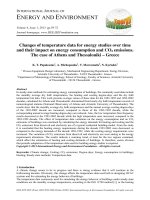Planning for 10Gbps Ethernet over UTP
Bạn đang xem bản rút gọn của tài liệu. Xem và tải ngay bản đầy đủ của tài liệu tại đây (200.39 KB, 6 trang )
WHITE PAPER
Planning for 10Gbps Ethernet
over UTP
Questions to Ask When Planning the Cabling Plant
Planning a copper cabling plant to support 10Gbps transmission is complicated
today by the absence of ratified standards. There are, however, some questions
you can ask that can help you navigate promises and claims in the market place
and, ultimately, help you select the proper infrastructure to support future
10Gbps UTP applications.
Do you really need a cabling plant that can support 10Gbps
Ethernet over UTP?
Historically speaking, cabling installed has always led the primary data rate. For
example, over 90% of switch port sales in 1995 were for the 10Mbps Ethernet
protocol. Yet in that same year, the primary UTP cabling installed was the
100Mbps Category 5, accounting for nearly 70% of UTP installed market share.
Similarly in 2001, about 70% of switch port sales were for 100Mbps. In the
same year, Category 5e and Category 6, which both support 1000Mbps,
accounted for over 80% of UTP cabling installed.
Of course, the next logical step in the data rate is another ten-fold increase to
10Gbps. With 10Gbps copper transceivers in development today and expected
to market in 2006, the cabling plant must be able to handle the new protocol.
Can Category 6 cabling support 10Gbps Ethernet over UTP?
Actually, Category 6 cabling can support 10Gbps transmission—but only to 55
meters, per TIA TR42.7, Cat 6–TSB155. However, this is a costly proposition. The
added construction costs for more telecom rooms to accommodate 55 meters
(vs. the standard 100 meters) are nominal compared to the added costs of
purchasing additional Ethernet switches and other active equipment for each
additional telecom room to support data, VoIP or other applications.
What draft standards are important?
Clearly, a 10Gbps UTP cabling solution should support the full 100 meters. From
a standards perspective, TIA TR42.7, Cat A6-568 B.2 Addendum 10 is the
current (May 2005) view to support 10Gbps transmission over UTP at 100
meters. Look for compliance with this standard as you shop for a solution. The
draft standards also require full interoperability and backwards compatibility.
Planning for 10Gbps Ethernet over UTP
Questions to Ask When Planning
the Cabling Plant
Planning for 10Gbps Ethernet over UTP
Page 2
What about shielded solutions?
Space, time and cost constraints were the drivers that led
to the development of UTP cabling in lieu of shielded
twisted pair (STP) solutions. Those reasons are still
prevalent today. Still there are manufacturers that do not
yet have a UTP solution and are promoting STP shielded
solutions for 10Gbps transmission over copper.
However, shielded cabling typically requires more space in
racks, cabinets, and raceways. Furthermore, grounding
and bonding is a concern for shielded cable installations.
Time to train and whether or not to ground at the
station and the closet varies geographically and by whom
you ask. Shielded cable construction will continue to be
more costly than UTP cable construction, as well as more
expensive to install. In fact, a recent ADC study
concluded that an STP network would typically cost three
times more than a UTP network.
Without TIA/EIA standards in place, what are
good decision criteria for selecting a 10Gbps
solution for UTP?
The cabling industry—TIA/EIA—does not drive the
electrical parameters needed to run transmission
protocols. It is the IEEE that develops proposed protocols,
understands what is needed from an electrical
perspective, and then gives TIA/EIA responsibility for
developing measurable parameters for the cable and
connectors.
When in doubt, follow the IEEE lead.
The IEEE 802.3 Study Group was formed to discuss how
best to approach running 10Gbps transmission over a
copper infrastructure. This group is composed of
representatives from chip manufacturers, switch
manufacturers, and cabling and connectivity
manufacturers. Discussions within the group include
which protocol encoding to use and how it relates to the
needed bandwidth or frequency range of the cabling
infrastructure. As of this writing (May 2005), it appears
as though the IEEE Study Group has recommended a
frequency range out to 500 MHz.
A key measurement established by this IEEE study group
is Shannon’s Capacity. Shannon’s Capacity is a measure
of how efficiently a cable can transmit data at different
rates, expressed in bits per second. The IEEE 802.3 Study
Group concluded that achieving 10Gbps transmission, at
100 meters requires at least 18Gbps from the cabling
solution. The additional capacity is required to
compensate for active hardware noise parameters such
as jitter and quantization.
Realizing that the cabling plant is designed to support
the requirements of active electronics, a Shannon’s
Capacity of at least 18Gbps is a good measure to
consider when evaluating 10Gbps UTP solutions.
ADC’s CopperTen 10Gbps UTP solution demonstrated
21Gbps over 100 meters for the IEEE 802.3 Study Group
in August 2003, easily exceeding the Shannon’s Capacity
minimum requirement of 18Gbps for all pair
combinations. Today, CopperTen has achieved greater
than 31 Gbps over 100 meters—offering more than
enough additional throughput to handle noise induced
by active electronics.
Have vendors had a tough time achieving
10Gbps over UTP at 100 meters?
Yes. By August 2003, the IEEE 802.3 Study Group had
seen no vendor UTP solution that could deliver 18Gbps
over UTP at 100 meters. In fact, the apparent lack of
vendor solutions led the IEEE Study Group to three
possible recommendations: lower the data rate to
2.5Gbps for Category 6 UTP; reduce the length of the
supported channel to 55 meters from the industry
standard 100 meters for Category 6 UTP; and use
shielded solutions and abandon UTP as a transport
medium for 10Gbps over copper.
KRONE, recently acquired by ADC, took on the challenge
and returned to the IEEE 802.3 Study Group just weeks
later to demonstrate CopperTen, the first augmented
Category 6 cable capable of transmitting at least 18Gbps
over 100 meters. After this demonstration, the IEEE
802.3 Study Group voted 64 to 0 to move forward with
a 10Gbps solution over UTP at 100 meters.
What is the biggest challenge to achieving a
minimum of 18Gbps over UTP?
For Category 5e and Category 6 solutions, the pair-to-
pair relationship is paramount to making good cable.
While these electrical characteristics remain important,
taming alien crosstalk remains the toughest hurdle for
any 10Gbps UTP solution at 100 meters.
Alien crosstalk is the noise heard on a pair within a cable
that is generated by another cable directly adjacent to it.
Manufacturers of active equipment do not like random
events such as alien crosstalk. While noise between pairs
within a cable can be predicted and eliminated within
the active hardware, unpredictable alien crosstalk cannot.
Crosstalk between pairs in a single UTP cable is often
cancelled out by varying the twist rate between different
pairs and increasing the distance between pairs. The
often-used star filler of Category 6 cable creates
separation by pushing pairs within the cable as close to
the jacket as possible. While this design reduces crosstalk
between pairs within the same cable, it leaves some pair
combinations between cables in the bundle susceptible
to high levels of crosstalk. This problem is magnified at
the higher frequencies of 500 MHz to 625 MHz of
10Gbps transmission.
Instead of using the typical star filler, ADC’s CopperTen
uses an elliptical offset star filler that achieves a high
degree of separation between pairs in adjacent cables in
a bundle. The shape of the elongated star filler results in
an oblique shape for each cable. Bundled cables now
have sufficient separation between same lay length pairs
to prevent alien crosstalk. In a bundle, the random
separation of cables keeps cable pairs of the same twist
rate within different cables at a greater distance from
one another—reducing alien crosstalk.
Because alien crosstalk presents the steepest challenge to
10Gbps over UTP, insist on seeing test results for the 6-
around-1 cable configuration.
Is cable insulation important?
Choice of insulation materials is critical in producing
10Gbps UTP cable. One key measure of insulation quality
is the Dielectric Constant—the lower the Dielectric
Constant of the insulation material of a cable, the better
the resistance to breakdown when an electrical field is
applied.
As a reference, the Dielectric Constant of air—the best
insulation available—is 1.0. Dielectric Constants for other
cable insulation materials are as follows: FEP—2.1;
FRPE—2.5; PVC—3.6; glass—4.3. The choice of
insulation materials plays a large part in cable
performance.
Insulation affects the speed at which a signal propagates
through a cable. Speed is measured as the Nominal
Velocity of Propagation (NVP), expressed as a percentage
of the speed of light in a vacuum (300 million m/sec),
with the speed of light in a vacuum given a value of 1.
The speed of the signal over a multi-pair data
communications cable can be attributed to two main
factors: the speed at which the signal is traveling (NVP)
and the total length of the cable pair, which allows for
twist rate. Both of these parameters combined are
measured as Propagation Delay, the time it takes for a
signal to propagate from one end of a circuit to the
other.
Therefore, cable constructed with insulation with a lower
Dielectric Constant—offering less resistance to an
electrical field—offers a higher NVP.
Insulation for ADC’s CopperTen cabling system uses the
unique AirEs technology that combines FEP with
integrated air pocket channels. Through the introduction
of air pockets between the FEP and copper conductor,
the total Dielectric Constant is reduced from 2.0 for FEP
alone to about 1.8 for FEP with air—a 31%improvement
over an FEP-only insulation system. The reduced dielectric
loss translates into a direct improvement in signal loss—
and improved NVP or, said differently, stronger signal
strength.
Of course, other 10Gbps cables may use only FEP or FRPE
insulation—both of which have a higher Dielectric
Constant that weakens signal strength. Improving the
Dielectric Constant of FEP by adding air—the AireES
technology—offers higher performance cable for 10Gbps
transmission.
Why is electrical cable pair length important?
The choice of cable insulation plays a role in electrical
cable pair length. Besides NVP, the other factor that
affects the speed of a signal over a multi-pair
communications cable is the electrical length of the cable
pair. Electrical length is always more than physical length
of the sheath due to twisting of the conductors.
As described above, the effect of faster NVP is low
Propagation Delay. However, Propagation Delay is also a
function of the actual length of the pair, including the
twist. The greater the twist rate, the longer the pair—
and the larger the Propagation Delay. In fact, excessive
propagation delay is often due to cable that is just too
long.
By utilizing the higher quality AirES insulation with air
channels between FEP and the copper conductor,
CopperTen cable requires a reduced amount of twist on
each pair. By reducing the electrical length of pairs,
Propagation Delay is reduced, improving the speed of the
signal between transmitter and receiver—especially
important as cabling runs reach the 100 meter physical
limit.
What is the impact of Delay Skew on 10Gbps
cable performance?
Delay Skew is the difference in time each signal requires
to arrive on all four pairs. Of course, optimal
performance and error free transmission means that
signals should arrive at the receiver as close to the same
time as possible. Delay skew of 45nS to 50nS between
the fastest and the slowest pairs is marginally acceptable
for data communications. Lower skew is better. Delay
skew below 25nS is desirable.
To achieve Near End Cross Talk (NEXT) performance,
most cable solutions must vary the twist lays greatly.
NEXT is, of course, more of a problem at higher
frequencies, such as with the 500MHz or better for
10Gbps solutions. To solve NEXT, some solutions actually
use different insulation for different pairs within the same
sheath, which ends up as unique twist ratios (i.e, varying
electrical length of cable pairs) per pair. Unfortunately,
greater variation in twist lays means an increase in Delay
Skew—a costly compromise when it comes to data
communications. While receivers can handle slight
variations is delay, a large skew will make it impossible to
recombine the original signal.
Planning for 10Gbps Ethernet over UTP
Page 3
Planning for 10Gbps Ethernet over UTP
Page 4
With the AirES innovation of introducing air—the best
insulator against noise—as an insulator, crosstalk is
reduced without having to greatly increase twist lay
variation. There is simply less crosstalk between pairs
because of reduced noise due to superior insulation.
Therefore, AirES technology and reduced need for twist
lay variation results in fewer bit errors as the propagation
delay between the fastest and slowest pairs is less than
20nS.
How should warranty promises be evaluated?
Until 568B.2 is ratified, it is impossible for any vendor to
guarantee full compliance to a standard that does not
yet exist. Until standards are established, it is more
important for a 10Gbps UTP solution to meet the
throughput and capacity requirements established by the
electronics industry—Shannon’s Capacity of 18Gbps. As
the standards evolve, manufacturers will continually
tweak individual parameters such as NEXT and return
loss, as we saw with Category 5e and Category 6. Still,
the only hard design number for 10Gbps over UTP today
is 18Gbps throughput as defined by IEEE.
ADC offers a warranty that backs 18Gbps channel
capacity and supports the current draft of 568B.2
Addendum 10.
Is cable diameter an issue with 10Gbps UTP
solutions?
Larger cable diameters can affect not only density but
also ease of installation and maintenance. To achieve the
requirements of draft standards for 10Gbps transmission
over UTP, some manufacturers today have 10Gbps UTP
cable with outside diameters (OD) ranging from 0.310"
to 0.330"—rather large in comparison to the nominal
size for conduit fill of 0.290" for the plenum CopperTen,
which has a varying OD from 0.275" to 0.310" due to
its elliptical shape.
Outside diameter is also a consideration for patch cords.
ADC’s CopperTen patch cord cable has an OD of
0.270"—which is dramatically smaller when compared to
the OD of the competitive cable which range from
0.310" to 0.330".
While these differences seem small, they become
significant installation and maintenance issues, especially
in dense applications.
Are patch cords changing for 10Gbps
transmission?
There is one change to look for when evaluating patch
cords for use in a 10Gbps channel—stranded vs. solid
wire. Some products have moved to solid wire patch
cords to achieve 10Gbps performance. Yet solid wire
patch cords present concerns.
Patch cords that employ solid wire sacrifice flexibility and
bend radii mechanics because solid wire is not as
forgiving and easy to install or manage as stranded wire.
Solid wire patch cord conductors are more prone to
breakage when repeatedly flexed during normal lifetime
usage. In addition, solid wire patch cords often have
reliability issues due to the difficultly of crimping RJ45
plugs on solid wire. As compared to stranded wire patch
cords, solid wire patch cords also place unnecessary stress
upon the connectors in NICs, patch panels and switches,
because of their uncompromising stature.
Conclusion
It is evident that 10Gbps transmission over a copper
cabling plant will soon become the common design
specification. While lack of standards today present some
risk in the decision making process, other factors offer
guidance when choosing cable, plugs and connectors to
support future 10Gbps applications. Choosing a solution
with the highest quality insulation—such as the AirEs
technology used for CopperTen—offers immediate
evidence of superior performance. Solutions that can
guarantee Shannon’s Capacity of 18Gbps at 100 meters
offer the best assurance that the channel will support
10Gbps transmission when standards are ratified next
year.









